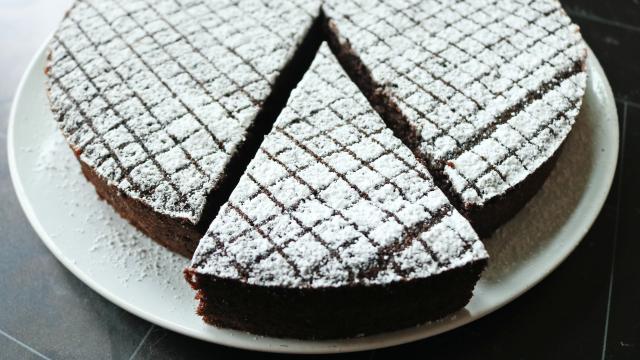I’m always game for a complicated dessert recipe—I love a challenge—but there’s a special satisfaction that can only come from not trying too hard and still being rewarded with cake. That’s where blender cakes fit in. If you swore off baking because of the whipping, creaming, and folding requirements that come along with some cake recipes, this might be the perfect trick to get you back in the saddle. Dust off those blenders; it’s time to make cake.
You’ve heard it before. Cream the butter and sugar until fluffy, add the eggs one at a time, alternate the dry ingredients with the wet ingredients until just combined—no, that’s too combined. These detailed and insufferable cake directions are owed to the process of emulsifying water and fat in a cake batter. It’s a precarious balancing act, and it’s usually accomplished with a slow and steady temperament.
For those of us without the virtue of patience, the blender can help. This post from Milk Street explains how the blender’s vortex slowly introduces the liquid fat to the eggs and other ingredients. At the push of a button, the blender blades will make a tornado of fat and water, emulsifying the liquid ingredients quickly and efficiently so you don’t have to.
Highly rated blenders to consider for your cake batters:
Which batters can go in the blender?
Not every cake recipe is a good candidate for dumping in your high-powered vortex-maker. Those recipes where egg whites are carefully folded in, or whipped eggs function as the leavening agent in any way are better to leave out of the blender. Look for cake recipes that use chemical leaveners, like baking powder or baking soda, instead.
Then there is the issue of gluten. Gluten is a protein in wheat flour. When mixed with water, the protein strands link together. This isn’t entirely a bad thing; after all, your breads and cakes need some structure. However, the more the gluten is agitated, the stronger the network becomes, and the structure can become overdeveloped and result in a rubbery cake. So, use your blender strategically. Allow me to explain.
How to mix a blender cake

In the case of gluten-free cakes, you can blend all of the room temperature ingredients (except mix-ins) at once because there’s no risk of overworking the gluten. Scrape down the sides a couple times to ensure even mixing and pour it into a prepared pan for baking.
For cakes that do use all-purpose or cake flour, use the blender to make quick work of emulsifying the fat and liquid, but keep the dry ingredients in a bowl to the side. Then simply whisk the wet ingredients into the dry before pouring the batter into the pan to bake.
Gluten-free cakes are a breeze in the blender
I decided to try Milk Street’s gluten-free chocolate cake, because I haven’t met a chocolate almond cake I didn’t love, but they have gluten-full blender cakes too. As expected, the cake was easy to make. I pulsed the ingredients in the blender about 10 times, scraped down the walls of the container, and pulsed it again. Any more futz-ing around would have potentially started whipping the eggs and been a waste of time, so I stopped and poured it into a prepared cake pan. After about 35 minutes in the oven, the cake was done. The result was tender and chocolatey without being too crumbly like some gluten-free recipes. A whole cake done with a mixing time of about 30 seconds.
There’s no wheat flour in this one, so all of the ingredients got dumped in for the ride, but let’s talk about fat briefly in case you’re using a recipe with wheat flour.
A note on butter
Milk Street’s chocolate cake uses milk, eggs, and butter for the wet ingredients. Since butter is solid at room temp, you need to heat it up in the microwave first before adding it to the blender. If you don’t, it’ll just break apart into bits of fat that surf around in the mixture, never fully emulsifying. Melt the butter first. That goes for any cake you decide to experimentally throw in the blender. If your cake recipe uses oil, great, dump it in, but butter should get a zap in the microwave first with a few minutes of cooling time to bring down the temp a smidge. Then add it to the blender.
The extra step of melting butter is nothing compared to the frustration of forgetting to bring your butter to room temperature. Blending cake batter is probably the most chill mixing technique I’ve tried. It’s so painless it kind of feels like getting away with something.

Leave a Reply
You must be logged in to post a comment.